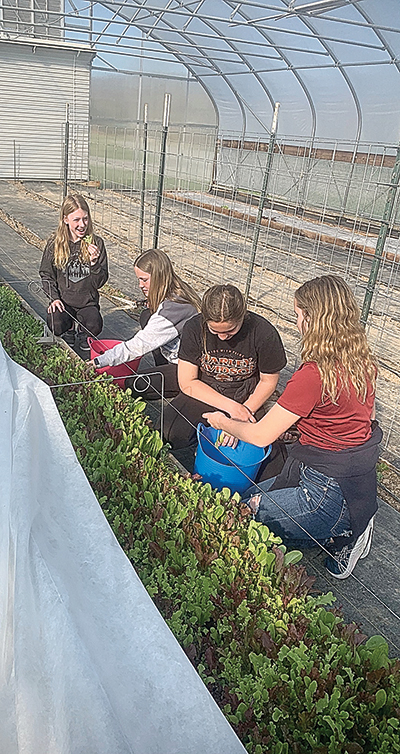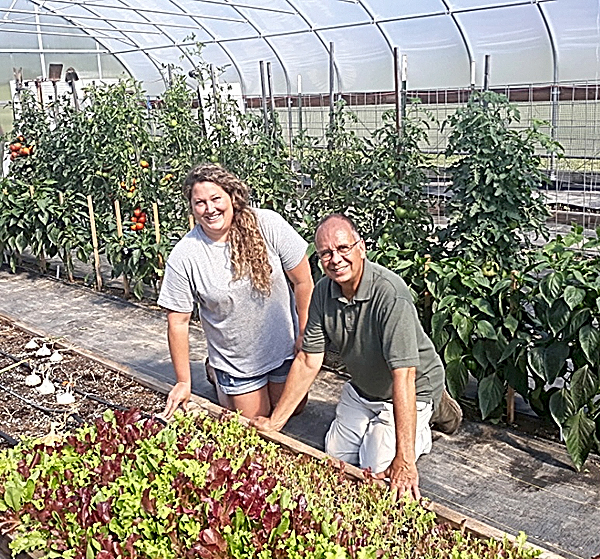
October is National Farm-to-School Month
Laura Dean Bennett
Staff Writer
Pocahontas County Schools began taking part in the Farm-to-School program in 2022.
The federal initiative, funded through the West Virginia State Department and administered by the Pocahontas County Board of Education, supports schools in purchasing fresh local produce, fruit and meat for school meals.
It’s a win-win situation for our local economy and students, as well.
Farm-to-School programs create opportunities for developing meaningful community relationships be- tween schools, parents and local farmers.
Local producers benefit by selling their produce to the school system and our young people benefit by being offered healthy food choices and learning how food is grown.
The program is a collaborative effort between the Board of Education, the West Virginia Food and Farm Coalition, the USDA and West Virginia Extension Service.
Through the wide-ranging program, students are the recipients not only of the fresh produce their schools are purchasing from local producers but also the food they themselves are growing in their school gardens.
And it seems to be getting rave reviews from everyone involved – most importantly, the students themselves.
The Farm-to-School program provides another market for local growers, and also offers the opportunity for students to learn where fresh food comes from as they take a hand in growing it themselves in the schools’ high tunnels and open air gardens.
In recent years, schools that participate in the Farm-to-School program have noticed that strengthening the connection between local food producers and local schools enriches the entire community.
Even in a rural community like ours, where we are certainly no stranger to farming, and many families raise gardens and tend fruit trees, some school age children may not be familiar with a wide variety of produce.
Fortunately, our school lunch programs are doing something about that.
Julie Shiftlet, Pocahontas County School Board Director of Child Nutrition, Technology and Testing, coordi- nates the many aspects of the Farm-to-School program in Pocahontas County Schools.
Shiftlet helps keep track of producers as well as what school needs which produce. She makes sure that each school has what it needs for each succeeding week during the school year.
“Our cafeteria staffs try to incorporate as much fresh and homemade food as possible into school meals,” Shiftlet said. “We’re always looking for ways to make our menus more appetizing for our students.”
“For instance, each month, we have a food of the month,” she continued.
“October’s food of the month will be pumpkin. There will be homemade pumpkin muffins, among other pumpkin dishes served.
“On the last Wednesday of the month, we have a program called West Virginia Wednesdays. All the school cafeterias will serve locally-sourced West Virginia meals consisting completely of locally or regionally-sourced added, proudly.
“We’re working with local farmers and Mountain Steer, a Greenbrier County company which certifies and distributes fresh, dry-aged beef within days of harvesting, so that we can serve local Pocahontas County beef in our schools,” she explained.
“The educational component is teaching our kids that they can grow their own fruits and vegetables at home. And you don’t need a huge garden to do it. They are learning about small raised beds and container gardening.
“We want our kids to know where their food comes from and what goes into a healthy diet. We need to expose them to things like spinach and micro greens – the little sprouts and seedlings of edible plants and herbs – at an early age.
“The more exposure, the better,” she added.
The Farm-to-School program has really been well received.
“The kids love the Garden Bar, and we’re hoping to do more and more with it as time goes on,” Shiftlet said. “The state guidelines encourage us to offer the freshest possible produce in school meals and we are glad to do it.”
Like all the schools, the Marlinton Middle School salad bar – Garden Bar – regularly features locally-sourced produce and food grown in conjunction with the Farm-to-School program.

Father Arthur Bufogle, of Pocahontas County’s Catholic churches, and Pocahontas County Extension Agent Luci Mosesso have been working hand-in-hand with the students at MMS to put fresh, healthy choices on the menu.
Father Arthur and the St. John Neumann Catholic Church provide seeds, equipment and fertilizer and Father Arthur provides the labor.
“We work with the cafeteria staff to determine their needs,” he explained.
“The middle school high tunnel provides lettuce, tomatoes, peppers, cucumbers, onions and, sometimes, peas for the salad bar.
“This gives students an opportunity to participate in growing and picking some of the food that will be served at their school at lunchtime,” he added.
Cooks at the middle school, Laura Sue Miller and Sherrie Howe, have embraced the concept of using locally-sourced fresh food.
They have the salad bar set up for every lunch.
“The Garden Bar is really Sherrie’s baby,” Miller said. “She keeps track of what we’re going to need each week. She really enjoys doing it and puts out great looking fresh food very day.”
Recently, local county growers have been offering potatoes, corn, fresh from the field, regular tomatoes, cherry tomatoes, cucumbers, and, of course, lettuce, every week.
“Our kids love the fresh vegetables,” Miller said. “We hear positive comments from them about the salad bar all the time. They especially like the little cherry tomatoes.”
The day I visited the middle school, lunch consisted of a chicken cutlet sandwich, baked beans, baked sweet potato fries and the salad bar, which was overflowing with fresh, healthy food. Sitting next to it was a bowl of Virginia apples.
The salad bar was a riot of colorful choices – several varieties of lettuce and green, red and lighter green peppers from Father Arthur and sliced cucumbers from the Ruby Grow (High Rocks) high tunnel in Hillsboro.
Shiny red tomatoes and onions from Melia Thompson in Green Bank were sliced and served on a platter with crisp, leafy lettuce.
As I enjoyed my lettuce, cucumber and tomato salad, I looked around at the students sitting at the lunch tables and saw many of them doing the same.
Middle school principal Nebraska Scotchie came through the cafeteria and commented on the salad bar.
“Our kids really love the salad bar,” she said. “It’s fun for them to pick what they want, and it gives them an option of an extra vegetable.”
Smiling and chatting with students as they perused the salad bar was sixth grade teacher Louisa Kiner, who assisted students with their choices.
The cooks serve lunch to 120 students, in two shifts, every school day at MMS.
Miller commented on the fact that many middle school girls are quite interested in making healthier food choices.
“Some girls at this age are watching their weight,” Miller said. “They love the salad bar.
“A lot of kids who don’t have gardens at home may not recognize all the fruits and vegetables. This gives them an opportunity to see and taste produce that may be new to them.
“Any time I can get a new or unusual vegetable out here for the kids to try, I like to offer it,” Scotchie added.
Miller has been the middle school cafeteria manager for 16 years.
“I started working under my mom, Betty Miller, at the elementary school, then transferred to the middle school under Mary Dilley.
“This Farm-to-School program will be an ongoing thing, and we’re hoping to add various new components, including locally-sourced meat, to our menus as time goes on,” Miller added.
Even in the winter – except usually in the months of January and February, when there’s just not enough sunlight for growing vegetables – students will still get produce from the county’s high tunnels.
“There may not be the abundance that there is in warmer weather, but we’ll still be getting fresh fruits and vegetables,” Miller said.
It takes a village, well, in this case, an entire county, to make the system work.
Local producers include North Fork Farm, Roseboro Farm, Ruby Grow, Wilfong Farms, Homegrown Harvest and Father Arthur.
The FFA starts seedlings for all the school gardening programs and sponsors youth entrepreneurship programs.
The WVU Extension Service pitches in, too.
“We provide a small piece of the budget for the Farm-to-School program,” Extension Agent Luci Mosesso said. “It’s a worthwhile investment in a healthy future for our kids,”
The MMS high tunnel has been used in many ways throughout the years – as an outdoor classroom, an art room and for plant production.
“Regardless of the activity, students are always eager to get into the space and work with their hands,” Mosesso added. “I haven’t met a student yet who didn’t like working there.
“Last spring, we had sixth and seventh grade students from a financial math class participate in several lessons in the tunnel. They worked to calculate fertilizer amounts, learned about planting seeds and how to determine the number of days to harvest.
“One of the most memorable moments from my time in the tunnel occurred when a seventh grade student came up to me outside of school and said, ‘We ate those peppers that we grew in the tunnel.’ She was so excited to have a connection to the food being served on the salad bar.
“Later her mom told me her daughter had never before chosen to eat raw vegetables, but that this experience had given her the desire to try new foods because she had helped grow them.”
“That’s what it’s all about, connecting our youth to the foods they eat and empowering them with new skills and knowledge.”
During the summer, when students are out of school, Eryn Neyer manages the Farm-to-School program, which encompasses a total of four greenhouses. She is the West Virginia Food and Farm Coalition’s Foodshed Coordinator for Pocahontas, Randolph and Pendleton counties.
In addition to managing four greenhouses, Neyer designs and teaches gardening and nutrition classes.
“I teach six-week gardening and nutrition classes called ‘Learn, Grow, Eat, Go’ to third through fifth grade students at Marlinton Elementary and first through fifth grade students at Hillsboro Elementary-Middle,” Neyer said.
She also provides early childhood lesson plans for initiating children into the world of gardening and healthy eating habits.
Last year, Neyer organized “taste testings” at the schools to introduce students to unfamiliar foods and “pop up markets” bringing local farmers to the schools for imitation farmer’s markets where students could meet the farmers and “shop” for fresh produce.
With October being National Farm to School month, Shiftlet and Neyer hope to get the word out about Pocahontas County’s Farm-to-School success, and they’re hoping students will carry the news.
“We’re rolling out a Farm-to-School marketing campaign,” Neyer said.
“There will be flyers up at all the schools featuring maps with our local producers’ names and locations so the students can see where their food is coming from.
“So far this calendar year, besides what we’ve received from local growers, our schools have harvested 530 pounds of vegetables from their gardens and high tunnels.”
It’s no secret that a healthy, balanced diet is critical for our health, whether we are adults, teenagers or younger children.
As many a parent will tell you, childhood is the best time to develop a willingness to try new foods and develop a taste for nutritious foods.
This makes it the perfect time to instill good habits that will last a lifetime and the Farm-to-School program is helping us do just that.



